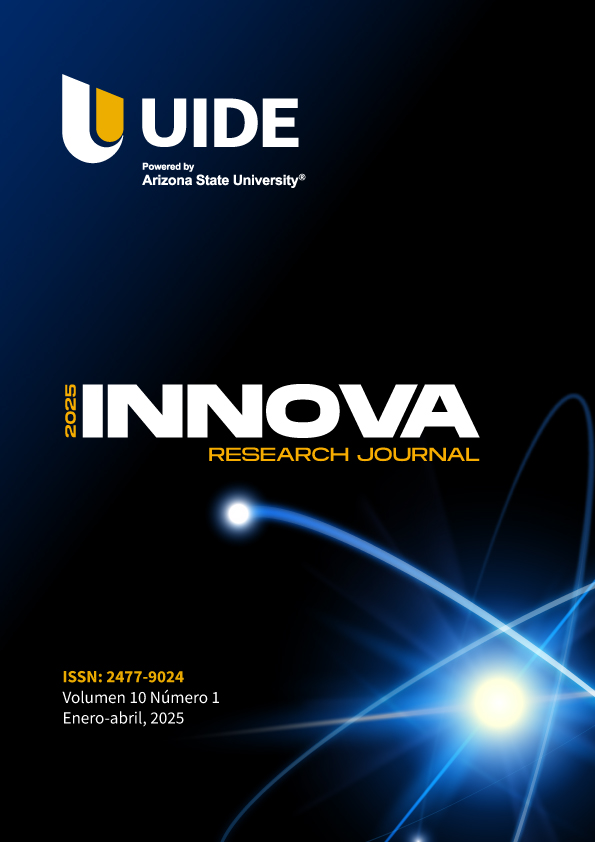Social assessment by gender when communicating technical and scientific information
Main Article Content
Abstract
Downloads
Article Details

This work is licensed under a Creative Commons Attribution-NonCommercial 4.0 International License.
COPYRIGHT NOTICE
Authors who publish in the INNOVA Research Journal keeps copyright and guarantee the journal the right to be the first publication of the work under the Creative Commons License, Attribution-Non-Commercial 4.0 International (CC BY-NC 4.0). They can be copied, used, disseminated, transmitted and publicly exhibited, provided that: a) the authorship and original source of their publication (magazine, publisher, URL and DOI of the work) is cited; b) are not used for commercial purposes; c) the existence and specifications of this license of use are mentioned.
References
Blades, A. H. (2011). Helping children correctly say “I don't know” to unanswerable questions. Journal of Experimental Psychology: Applied, 17(4), 396–405. https://doi.org/10.1037/a0026150
Bernardo, Á. (2013, junio 18). ¿Está la maldad escrita en nuestros genes? https://hipertextual.com/2013/06/maldad-escrita-en-nuestros-genes
Bertomeu, G. (2011). Nativos digitales: una nueva generación que persiste en los sesgos de género. Revista de Estudios de Juventud (92), 187-200.
Braman, D. & Kahan, M. (2011). Cultural cognition of scientific consensus. Journal of risk research, 14(2), 147-174. https://scholarship.law.gwu.edu/cgi/viewcontent.cgi?article=1269&context=faculty_publications
Bozzato, P., Fabris, M. A., & Longobardi, C. (2021). Gender, stereotypes and grade level in the draw-a-scientist test in Italian schoolchildren. International Journal of Science Education, 43(16), 2640-2662. https://doi.org/10.1080/09500693.2021.1982062
Carmelo Polino, Y. C. (2019). Percepción pública de la ciencia en Iberoamérica. Evidencias y desafíos de la agenda a corto plazo. Revista Iberoamericana de Ciencia, Tecnología y Sociedad, 14(42), 115-136. https://www.redalyc.org/journal/924/92462512008/html/
Carmona-Contreras, S. C., Torres-Zúñiga, V. (2019). Google Sheets. https://docs.google.com/spreadsheets/d/1XgJEgBXuVWZwecX38xGsSNx3VSMkCQ73/edit?usp=sharing&ouid=109679703427109934867&rtpof=true&sd=true
Eaton, A.A., Saunders, J.F., Jacobson, R.K. et al. (2020). How gender and race stereotypes impact the advancement of scholars in STEM: Professors’ biased evaluations of physics and biology post-doctoral candidates. Sex roles, 82 (127-141). https://doi.org/10.1007/s11199-019-01052-w
FECYT, F. E. (2022). Encuesta de percepción social de la ciencia y la tecnología en España.
Google LLC. (n.d.). Google Sheets. https://docs.google.com/spreadsheets/
Heffernan, T. (2022). Sexism, racism, prejudice, and bias: A literature review and synthesis of research surrounding student evaluations of courses and teaching. Assessment & Evaluation in Higher Education, 47(1), 144-154. https://doi.org/10.1080/02602938.2021.1888075
Instituto Nacional de las Mujeres, México. (2007). El impacto de los estereotipos y los roles de género en México. http://cedoc.inmujeres.gob.mx/documentos_download/100893.pdf
Llorens, A., Tzovara, A., Bellier, L & Bhaya-Grossman, I. (2021). Gender bias in academia: A lifetime problem that needs solutions, Neuron,Neuron, 109(13), 2047-2074. https://doi.org/10.1016/j.neuron.2021.06.002
Maeder, E. M., McManus, L. A., McLaughlin, K. J., Yamamoto, S., & Stewart, H. (2016). Jurors’ perceptions of scientific testimony: The role of gender and testimony complexity in trials involving DNA evidence. Cogent Psychology, 3(1). https://doi.org/10.1080/23311908.2016.1264657
Menacho, R. V. (n.d.). Los hombres que no escuchaban a las mujeres. https://www.youtube.com/watch?v=vf4CR1sd8FQ
Menacho, R. V. (2018). Reflexiones sobre feminismo y lenguaje inclusivo y mi experimento. https://www.youtube.com/watch?v=sF9XLd19fR4
Moss-Racusin, C, Dovidio, J., Brescoll, V., Graham, M., & Handelsman, J. (2012). Science faculty’s subtle gender biases favor male students,» Proceedings of the national academy of sciences. 109(41), 16474-16479. https://doi.org/10.1073/pnas.1211286109
Polino, C. (2011). Los estudiantes y la ciencia : encuesta a jóvenes iberoamericanos. Buenos Aires: Organización de Estados Iberoamericanos para la Educación.
Rangel, T. d. (2023). Retos para la educación inclusiva de las niñas, niños y adolescentes de familias jornaleras agrícolas migrantes. Revista Iberoamericana de Educación Rural, 1(1), 49 -65.
Segovia-Saiz, C., Briones-Vozmediano, E., Pastells-Peiró, R., González-María, E., Gea-Sánchez, M. (2021). Techo de cristal y desigualdades de género en la carrera profesional de las mujeres académicas e investigadoras en ciencias biomédicas. Gaceta Sanitaria, 34(4), 403-410. https://dx.doi.org/10.1016/j.gaceta.2018.10.008
Squazzoni, F., Bravo, G., Farjam, M., Marusic, A., Mehmani, B., Willis, M., Birukou, A., Dondio, P., & Grimaldo, F. (2021). Peer review and gender bias: A study on 145 scholarly journals. Science advances, 7(2). https://doi.org/10.1126/sciadv.abd0299
The MathWorks. (n.d.). MathWorks. https://la.mathworks.com/products/matlab.html
Verdugo-Castro, S., M. C.-G.-H. (2022). University students’ views regarding gender in STEM studies: Design and validation of an instrument. Education and Information Technologies, 27(9), 12301-12336. https://doi.org/10.1007/s10639-022-11110-8
Wetenschappen, J. P. (2015, enero 2). Wikimedia Commons. Wikimedia Commons.
Wetenschappen, K. K. (2019, septiembre 29). Wikimedia Commons. https://commons.wikimedia.org/wiki/File:Mari%C3%ABtte_Boon_%2826739257194%29.jpg
Younan, M. (2023). What makes an expert persuasive? Examining the influence of evidence quality and superficial cues on jurors' evaluation of expert evidence. Sydney: UNSW.






